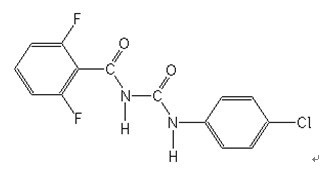DIFLUBENZURON
Common name: Diflubenzuron
CAS No: 35367-38-5
Chemical name: 1-(4-chlorophenyl)-3-(2,6-difluorobenzoyl)urea
Empirical formula:C14H9ClF2N2O2
Molecular weight: 310.7
Structural formula: 
Physical & Chemical Properties:
Appearance: pale yellow to white powder
Melting point: 210~230℃
Vapour pressure: <0.013mPa
Solubility: in water---0.1mg/L, 20℃
Solubility in organic solvent: acetone---6.5g/L; DMSO---120g/L; methanol---0.9g/L
Partition coefficient: octanol/water---5000
Stability: stable at normal storage conditions.
Application: Diflubenzuron is a benzoylphenylurea chitin synthesis inhibitors insecticide, it's used on forest and field crops to selectively control insects and parasites. Principle target insect species are the gypsy moth, forest tent caterpiller, several evergreen eating moths and the boll weevil, apple rust mite, codling moth, leaf miners, leaf rollers, pear suckers, winter moth, plum fruit moth, olive moth, army worms, rice water weevil, rice leaf roller, mosquitos. Diflubenzuron is a stomach and contact poison which acts by inhibiting the production of chitin (a compound that makes the outer covering of the insect hard) and so interferes with the formation of the insect's cuticle or shell. It is also used as a larvae control chemical in mushroom operations and animal houses. The recommended rate of application is 1.5-30 g AI/100 litre of water effective against: leaf-feeding larvae and leaf miners in forestry, top fruit, citrus, field crops including cotton and soyabeans, horticular crops. It is also effective against the larvae of sciaridae and phoridae in mushrooms (1 g/m2 casing at case mixing, or as a drench in 2.5 litres of water to the finished casing); mosquito larvae (20-45 g/ha water surface); fly larvae as a surface application in animal housing (0.5-1.0 g/m2 surface).
Goods available: Diflubenzuron 96%min technical; 25% WP, 40% SC
Package: 25kg fiber drum UN-approved.

